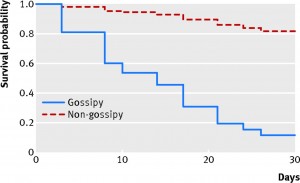It’s beginning to look a lot like Christmas
In particular, we have the Christmas issue of the BMJ, which is devoted to methodologically sound papers about silly things (examples including last year’s on virgin birth in the National Longitudinal Study of Youth, and the classic meta-analysis of randomised trials of parachute use)
University of Auckland researchers have a paper this year looking at the survival rate of magazines in doctors’ waiting rooms
We defined a gossipy magazine as one that had five or more photographs of celebrities on the front cover and a most gossipy magazine as one that had up to 10 such images. The Economist and Time magazine were deemed to be non-gossipy. The rest of the magazines did not meet the gossipy threshold as they specialised in, for example, health, the outdoors, the home, and fashion. Practice staff placed 87 magazines in three piles in the waiting room and removed non-study magazines. To blind potential human vectors to the study, BA marked a unique number on the back cover of each magazine. Twice a week the principal investigator arrived at work 30 minutes early to record missing magazines.
And what did they find?
Thomas Lumley (@tslumley) is Professor of Biostatistics at the University of Auckland. His research interests include semiparametric models, survey sampling, statistical computing, foundations of statistics, and whatever methodological problems his medical collaborators come up with. He also blogs at Biased and Inefficient See all posts by Thomas Lumley »

I have not read the paper but one of the authors (prinipal?) was interviewed on the Canadian Broadcasting Corporation a week or so ago.
An excellent study (I was just in my doctor’s office a week ago) and the beautifully dry delivery by the interviewee was excellent. I believe he even ended the interview with a plea for more funding to carry out further, needed research.
10 years ago